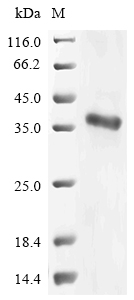Recombinant Arabidopsis thaliana GRF1-interacting factor 1 (GIF1) is produced in an E. coli expression system, spanning the complete protein sequence from amino acids 1 to 210. The protein carries an N-terminal 6xHis-KSI tag, which appears to simplify purification and detection processes. SDS-PAGE analysis indicates purity levels above 85%, suggesting this recombinant GIF1 may be appropriate for various research applications. This product is intended for research use only.
GIF1, or GRF1-interacting factor 1, is a protein from Arabidopsis thaliana that seems to play an important role in regulating plant growth and development. It likely interacts with growth-regulating factors, potentially influencing pathways that are crucial for morphological adaptations and responses to environmental stimuli. Studying GIF1's interactions and functions might provide valuable insights into plant biology and could aid researchers exploring plant developmental processes.
Potential Applications
Note: The applications listed below are based on what we know about this protein's biological functions, published research, and experience from experts in the field. However, we haven't fully tested all of these applications ourselves yet. We'd recommend running some preliminary tests first to make sure they work for your specific research goals.
The E. coli system lacks eukaryotic chaperones and post-translational modification machinery, increasing the likelihood of misfolding or inclusion body formation. Furthermore, the N-terminal 6xHis-KSI tag (where KSI is ketosteroid isomerase, a large fusion partner) could sterically interfere with the correct folding of the N-terminal region of GIF1, which is critical for its interaction with GRF proteins. Therefore, this recombinant GIF1 protein is highly likely to be incorrectly folded and lack bioactivity due to the E. coli expression system and the potential interference of the N-terminal 6xHis-KSI tag. Experimental validation is essential before any functional application.
1. Protein-Protein Interaction Studies with GRF Transcription Factors
The recombinant GIF1 protein could be used to study interactions with GRF transcription factors only if its correct folding is experimentally verified. The His-tag allows technical immobilization for pull-down assays. However, if the protein is misfolded, its interaction interfaces may be altered, leading to false-negative results (failure to bind GRFs) or non-physiological bindings. The N-terminal tag is particularly concerning, as the N-terminal region of GIF1 is directly involved in GRF binding. Any interaction data must be validated with native proteins from plant tissues.
2. Antibody Development and Validation
This recombinant GIF1 protein can serve as an immunogen for generating antibodies targeting linear epitopes, as antibody production often relies on amino acid sequences rather than native conformation. The full-length sequence provides comprehensive epitope coverage. However, if antibodies are intended to recognize the native, correctly folded GIF1 in its physiological context (e.g., for immunofluorescence or co-immunoprecipitation), misfolding of the recombinant antigen may result in antibodies that fail to bind the natural protein. The high purity reduces risks from contaminants, but the tag might induce tag-specific antibodies.
3. Biochemical Characterization and Structural Studies
The protein is unsuitable for meaningful biochemical or structural analysis without prior folding validation. Techniques like circular dichroism or dynamic light scattering could be applied, but data from a misfolded protein would not reflect the native structure of GIF1. The large KSI fusion tag may dominate biophysical properties and obscure GIF1-specific characteristics. For structural studies (e.g., X-ray crystallography), a correctly folded, homogeneous sample is essential; a misfolded protein would yield uninterpretable results.
4. His-Tag Affinity-Based Functional Assays
The His-tag enables technical applications like immobilization on nickel surfaces for affinity purification or screening. However, functional assays (e.g., screening for modulators) are entirely dependent on bioactivity. If GIF1 is misfolded and inactive, assays designed to study its function would produce invalid results. The tag facilitates protein handling, but cannot compensate for the lack of native structure. Any functional findings require confirmation with bioactive GIF1.
Final Recommendation & Action Plan
Given the high probability of misfolding, the immediate priority is to experimentally validate the protein's conformation and bioactivity before any application. Start with biophysical characterization using size-exclusion chromatography coupled with multi-angle light scattering (SEC-MALS) to assess oligomeric state and monodispersity, and circular dichroism spectroscopy to analyze secondary structure. Then, perform a functional protein-protein interaction assay using a known GRF protein as a positive control to test binding capability . If the protein shows evidence of correct folding and GRF-binding activity, it can be cautiously used for interaction studies or as an immunogen for linear epitope antibodies (with disclosure of limitations). If validation fails, the protein should only be used for technical practices like tag-based purification training or as a negative control in folding studies, and not for biological investigations. Always explicitly state the lack of functional validation in any research communications.






